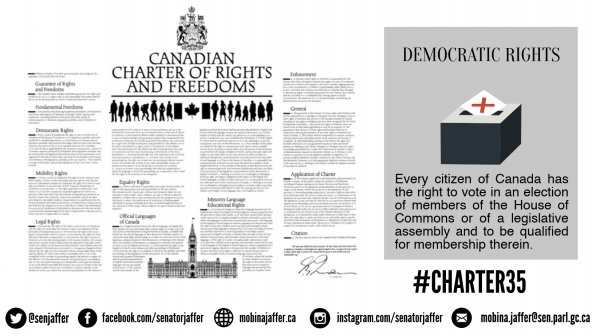
In my last entry for this series, I demonstrated how the democratic rights outlined in sections 3-5 of the Canadian Charter of Rights and Freedoms were designed to prevent the return of laws from Canadian history that either disenfranchised specific groups or interfered with the fairness of elections.
However, by the time the Charter was signed in 1982, most of these laws had been repealed. As a result, the Charter has primarily been used to test whether remaining limitations on democratic rights were reasonable.
Out of all the democratic rights, Section 3 has easily seen the most changes as a result of these tests. In recognition of this fact, today’s blog will focus on the evolution of voting rights, while next week’s blog will cover the other democratic rights.
When the Charter came into effect, individuals with mental illnesses were among the first to use it to challenge laws that denied them the vote. In response to these challenges, the government argued that these laws were reasonable, and made the claim that mentally ill people could not make rational choices.
Thankfully, the courts realized that many people who suffer from mental illnesses are still fully capable of making informed decisions, and restored their right to vote. The courts even went as far as to state that in most cases, if Canadians have the ability to exercise their right to vote, they also have the right to use it!
With that said, it took a long time for this principle to be applied to inmates, who were denied the right to vote under the Canada Elections Act. When inmates challenged these laws, the government claimed that the restrictions were reasonable because of how elections worked. According to the government, voting involves making a decision based on interactions with society. Since inmates cannot interact with society; they cannot make an informed choice, and therefore should not vote.
Given that inmates can obtain information from sources outside of prison, this is obviously untrue. However, it would take 8 whole years before the court recognized this and granted them voting rights through the Belcowski case.
With that said, the Belcowski case led to the first vote by inmates in the 1992 federal elections. 28,000 inmates across Canada were given information packages and newspapers, and successfully voted. To this day, they still enjoy this inalienable right.
Despite this history of fighting for the right to vote, several disputes on the right to vote remain unsettled to this very day.
Most notably, several groups are pushing for mature minors to earn the vote. Few people disagree that there are legitimate reasons to deny minors who are still mentally developing the vote. However, many people rightfully argue that mature minors can make informed decisions despite their age!
This debate is still being fought in the courts today.
Today, most Canadians consider the right to vote a given- it is an inalienable right, that every Canadian can exercise to choose the people who will represent them. However, this has not always been the case; several groups had to fight for this right using the Charter, and several more fight for it to this very day!
Please look forward to my next entry in this series, where I will take a look at how other democratic rights have been affected by the Charter.